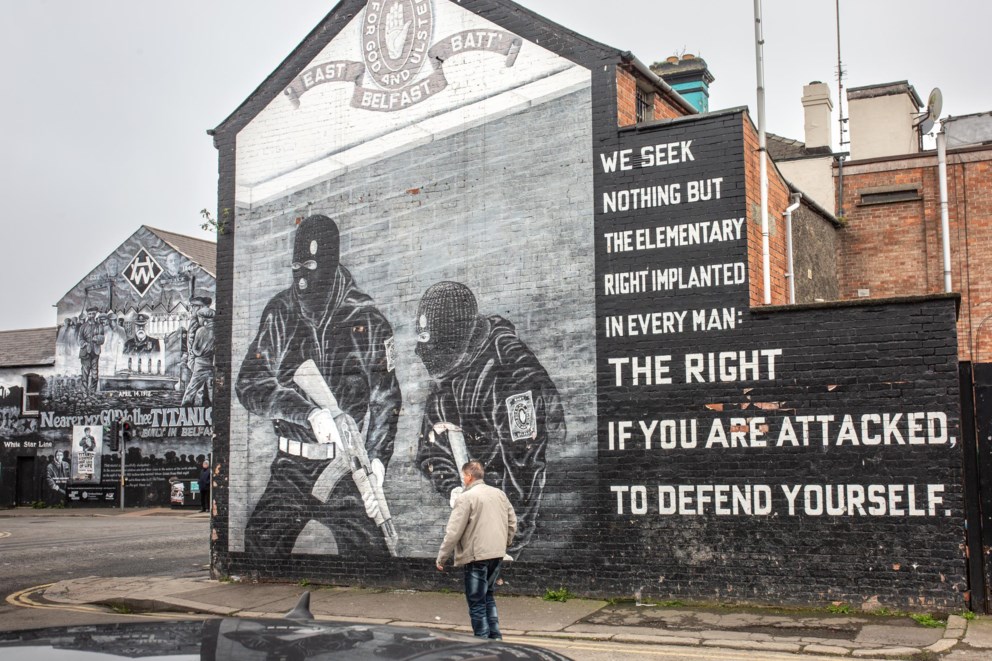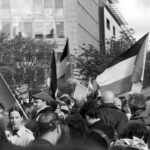Twenty-five years after the end of the civil war in Northern Ireland, real peace is still waiting. Protestants and Catholics still largely live in segregation, while paramilitaries continue to stir. “We have never seen peace in our neighborhood.”
Just outside the 17th-century city walls of the Northern Irish city of Derry, the neo-Gothic tower of a Protestant church rises above the gray roofs. At the stately doors of the building, Reverend Robert Miller welcomes the parishioners. The Catholic mass also starts in the cathedral across the street. “Protestants and Catholics praying side by side in peace, no one would have dared to hope 25 years ago,” Miller says, waving to his colleague.
Within the city walls, between the derelict textile mills and Victorian terraced houses of Derry, the Troubles began in 1969. For thirty years, Catholic supporters of a united Ireland and Protestant supporters of British rule fought each other. After difficult peace talks, the historic Good Friday Agreement was signed in 1998, which was supposed to bring peace and reconciliation between the two communities in Northern Ireland.
Before, Miller couldn’t set foot in this Catholic part of town. Now he prides himself on the fact that his church is a safe haven for Protestants and Catholics alike. But according to the cleric, it is still too early to celebrate the Good Friday Agreement. “It could just explode here again. All you need is a spark.” During his sermon, Miller warns his churchgoers of the dangers that could disrupt the peace in Northern Ireland.

Murder of a journalist
In recent years, the Brexit referendum has sharpened the old contradictions again. Pro-British Unionists fear further removal from the United Kingdom, Catholic Republicans a new border with Ireland. Border controls in Northern Ireland’s ports led to delays and empty shelves in supermarkets. Northern Irish politics is also in crisis. The Republican Sinn Fein became the largest group in the Northern Ireland Parliament in 2022 for the first time in its existence. The unionist DUP party would therefore no longer automatically provide the prime minister. Although the Good Friday Agreement stipulates that both sides must rule together to keep the peace, the DUP has since blocked any formation of a regional government.
Violence is also inevitable. In 2019, a New IRA paramilitary in Derry shot and killed journalist Lyra McKee. “Lyra’s murder sent shock waves through Northern Ireland,” says Kathleen Bradley, one of her best friends. For many, McKee was the symbol of the so-called peace generation, raised after the Good Friday Agreement. “Lyra looked beyond the labels that divide people in Northern Ireland,” says Bradley. Her murder was a turning point. Everyone feared a return to violence.”
All political parties unanimously condemned the attack, but, according to Bradley, missed the opportunity to bury the differences. Lyra’s murder was a pivotal moment in Northern Ireland, but we didn’t capitalize on it. Death and violence remain the price of political division.”

Deprived neighbourhoods
The Good Friday Agreement was supposed to ensure that paramilitary organizations surrendered their weapons, but a complete disarmament did not materialise. Paramilitary attacks remain commonplace, with a marked increase in the past year. Republican groups mainly target the police, which they see as continuators of British rule. In February, John Caldwell, a local police superintendent, was shot just outside Derry while coaching his children’s soccer team. Since then, families of police officers have also been seen as ‘legitimate targets’.
According to Dale Pankhurst, who researches conflict and paramilitarism at Queens University, the problem should not be underestimated. For many politicians, both in Northern Ireland and internationally, peace in Northern Ireland is a completed process. But you feel a lot of dissatisfaction among the people.’ The deprived neighborhoods in Northern Ireland are the ideal breeding ground for radicalisation, warns Pankhurst. The economic problems and the lack of prospects make young people especially susceptible to recruitment in republican and unionist paramilitary groups. You may not see as many guns as you used to, but many people here are still mentally at war.”

Peace Walls
The center of Belfast, the capital of Northern Ireland, today hardly resembles the bloody conflict zone of the Civil War. Hip coffee bars and pubs line the streets where armored British army vehicles used to drive. New office buildings and apartments surround the Europa Hotel, which was bombed 36 times during the Troubles.
But the picture quickly changes when you move into the surrounding working-class neighborhoods. The republican and unionist neighborhoods are mixed up like a patchwork quilt. Flags, monuments, murals and parades are ubiquitous. During the Troubles, those segregated neighborhoods were hotspots of violence and terror. The intersections between Catholic and Protestant streets became notorious as battlefields. To stop the bloodshed, the British army built temporary walls between the neighbourhoods. Fifty years later, these so-called Peace Walls still tower over the houses over a length of 34 kilometers. Since the Good Friday Agreement, they have even increased in height and number.
A 2013 government plan to remove all barriers by this year made little progress. Partly because of political impotence, partly because of resistance from both communities. A 2019 poll found that 42 percent of residents prefer to keep the walls for safety reasons. Mark, a resident of a Unionist neighborhood and a former Unionist paramilitary, does not see the walls disappearing any time soon either. “We lived apart for years. No trust has been built. How are we supposed to suddenly live together?”
The working-class neighborhoods on both sides of the walls are still segregated for 90 percent today. Each neighborhood has its own church, convenience store and associations. Most children attend segregated schools and meet in separate community centers. “What has the peace treaty ever done for us?” asks Sinead, an elderly woman in one of the Republican neighborhoods.

Camera surveillance
For many working-class residents, the political instability in Northern Ireland shows that the Good Friday Agreement is not working properly. In the past 25 years, Northern Ireland has had no government for seven years. Due to the absence of decisive policy, it is mainly up to local initiatives and organizations to bring both communities closer together. Sean Oliver, a community worker with a Catholic background, takes us to a busy intersection between a Republican and Protestant neighborhood. “This was one of the bloodiest places during the conflict,” he says. Here too, a brick wall with barbed wire had to keep the violence in check for 40 years. Government officials assigned to implement the government’s ten-year plan were met with hostility on both sides. “You have to build up trust over the years by talking to residents and listening to their concerns. An official from out of town doesn’t stand a chance here.”
Oliver and his colleagues succeeded in making a breakthrough. He shows a photo of the former wall on his iPad, after which he proudly points to a black iron gate that is wide open. “The Protestants were very concerned about the opening of the wall. They were reassured with the assurance that the gate would close at night and that there would be camera surveillance. But the fact that this gate is open during the day is already quite a victory,” says Oliver with a smile. “It’s a step towards a world without walls.”
Archenemies
Hours before the gates between the Republican and Unionist quarters close for the night, two elderly men enter a local youth center in West Belfast. Gerry McDonnell, a former IRA member, was arrested in the 1970s for the murder of a police officer. Dressed in an all-green outfit, with only his tattooed forearms bare, he takes a seat on a makeshift stage. Jim Potts, a former Unionist paramilitary who was captured plotting a bombing, takes a seat next to McDonnell.
Both men were released twenty-five years ago under the Good Friday Agreement. The former sworn nemesis are now touring Northern Ireland together to share their experiences. In this community center, young people from both communities come together for the first time to listen to their testimonies. The young people don’t really know each other well. Initially, they shift uncomfortably in their seats, secretly pull their e-cigarettes or play games on their mobile phones.
Unperturbed, the ex-paramilitaries talk in detail about the violence and bloodshed for which they were responsible. The room soon falls silent. All eyes and ears are on the two men. An older boy interrupts the duo and asks if it isn’t hypocritical to proclaim peace now after all those murders. McDonnell looks him straight in the eye. “Peace is far from perfect,” he says in a deep, awe-inspiring voice. “It is a peace with walls, with violence and trauma. But remember: you are better off than previous generations. And it’s up to you to make something of it.”
This report was realized with the support of Journalismfund.



